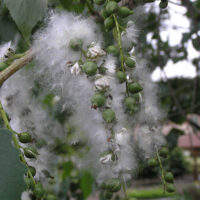 Purdue University - Extension - Forestry and Natural Resources
Purdue University - Extension - Forestry and Natural Resources
Got Nature? Blog
 Populus deltoides, more commonly known as the Eastern cottonwood, becomes a topic of conversation & complaint every year around this time. A member of the willow family, this tree is found along rivers, roads, in parks, and around residential areas. It grows to heights of 75 to 100 feet spanning up to 75 feet wide. It prefers moist to wet well-drained soils but tolerates many types of sites. Cottonwoods also produce small seeds with a tuft of cotton fluff (to assist with dispersal) that can number in the millions for a single tree.
Populus deltoides, more commonly known as the Eastern cottonwood, becomes a topic of conversation & complaint every year around this time. A member of the willow family, this tree is found along rivers, roads, in parks, and around residential areas. It grows to heights of 75 to 100 feet spanning up to 75 feet wide. It prefers moist to wet well-drained soils but tolerates many types of sites. Cottonwoods also produce small seeds with a tuft of cotton fluff (to assist with dispersal) that can number in the millions for a single tree.
That’s right, we are in the season of the cottonwood seed. You may be walking or driving around or just looking out your window and it can look like winter is trying to attack with one last blizzard before summer sets in. Seed production occurs between May and June for about 2 weeks with the floating cotton balls accumulating on roads and paths, in yards and parks, and in other locations with a little bit of grab. Seedlings easily germinate, but are delicate, and in urban areas with an abundance of lawn care, many do not survive or are killed by excessive heat or rain.
Many concerns that I hear about are clogging of waterways or air filters, and the worry of fires. Seeds usually flow easily downstream without the volume or mass to clog waterways. They can accumulate on air conditioner units or other filters but are easily cleaned off. Cottonwood seeds are highly flammable, can pose a risk in drier climates, and should not be ignited to clean them up. They can be cleaned like leaves with fine-tined rakes or picked up in clusters and bagged. The good news is this usually only lasts for about 2 weeks.
If you do have any questions about managing your cottonwood trees, feel free to contact your local extension office or you can search for ISA-certified arborists in your area at Find an Arborist.
Resources:
ID That Tree, Playlist, Purdue Extension – FNR YouTube Channel (Invasive White Mulberry, Siberian Elm, Tree of Heaven)
Eastern Cottonwood, Article, Purdue Fort Wayne
Find an Arborist video, Trees are Good-International Society of Arboriculture (ISA)
A Woodland Management Moment, Playlist, Purdue Extension – FNR YouTube Channel (Against Invasives, Garlic Mustard, Autumn Olive)
Woodland Stewardship for Landowners, Playlist, Purdue Extension – FNR YouTube Channel (Common Buckthorn, Japanese Barberry)
Trees and Storms – The Education Store, Purdue Education’s resource center
Planting Your Tree, Video, The Education Store
Tree Installation, The Education Store
Indiana Invasive Species Council
Indiana Department of Natural Resources: Invasive Species
Subscribe – Purdue Extension-FNR YouTube Channel
Ben McCallister, Urban Forestry Specialist
Purdue Forestry & Natural Resources

Recent Posts
- New Indiana Woodland Steward Newsletter, Stumpage Timber Price Report
Posted: May 3, 2025 in Forestry, Timber Marketing, Woodlands - ID That Tree: Black Raspberry
Posted: May 2, 2025 in Forestry, Urban Forestry, Woodlands - Publication – Goldenrod Control
Posted: April 30, 2025 in Forestry, Invasive Plant Species, Wildlife - White-tailed Deer Impact on Indiana Woodlands, Hoosier Ag Today
Posted: April 29, 2025 in Wildlife, Woodlands - Top 10 Spring Flowering Shrubs, Purdue Landscape Report
Posted: April 28, 2025 in Gardening, Plants, Urban Forestry - HTIRC Continues to Protect Our Hardwood Forests
Posted: April 18, 2025 in Forestry, Timber Marketing, Woodlands - Tips to Manage Storm-Damaged Trees, Purdue Landscape Report
Posted: April 17, 2025 in Forests and Street Trees, How To, Urban Forestry - Liz Jackson Receives IHLA’s President’s Award, Featured in ANR Newsletter
Posted: in Forestry, Timber Marketing, Wildlife, Wood Products/Manufacturing, Woodlands - A Woodland Management Moment: Bottomland Forests
Posted: in Forests and Street Trees, Urban Forestry, Wildlife, Woodland Management Moment, Woodlands - When is the Peak Migration For Hummingbirds and How Can You Attract Them?
Posted: April 4, 2025 in How To, Wildlife
Archives
Categories
- Alert
- Aquaculture/Fish
- Aquatic/Aquaculture Resources
- Ask the Expert
- Christmas Trees
- Community Development
- Disease
- Drought
- Forestry
- Forests and Street Trees
- Gardening
- Got Nature for Kids
- Great Lakes
- How To
- Invasive Animal Species
- Invasive Insects
- Invasive Plant Species
- Land Use
- Natural Resource Planning
- Nature of Teaching
- Plants
- Podcasts
- Ponds
- Publication
- Safety
- Spiders
- Timber Marketing
- Uncategorized
- Urban Forestry
- Webinar
- Wildlife
- Wood Products/Manufacturing
- Woodland Management Moment
- Woodlands